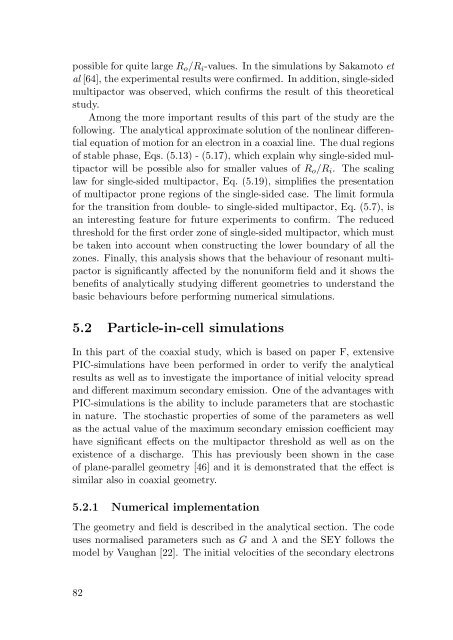Multipactor in Low Pressure Gas and in ... - of Richard Udiljak
Multipactor in Low Pressure Gas and in ... - of Richard Udiljak
Multipactor in Low Pressure Gas and in ... - of Richard Udiljak
You also want an ePaper? Increase the reach of your titles
YUMPU automatically turns print PDFs into web optimized ePapers that Google loves.
possible for quite large Ro/Ri-values. In the simulations by Sakamoto et<br />
al [64], the experimental results were confirmed. In addition, s<strong>in</strong>gle-sided<br />
multipactor was observed, which confirms the result <strong>of</strong> this theoretical<br />
study.<br />
Among the more important results <strong>of</strong> this part <strong>of</strong> the study are the<br />
follow<strong>in</strong>g. The analytical approximate solution <strong>of</strong> the nonl<strong>in</strong>ear differential<br />
equation <strong>of</strong> motion for an electron <strong>in</strong> a coaxial l<strong>in</strong>e. The dual regions<br />
<strong>of</strong> stable phase, Eqs. (5.13) - (5.17), which expla<strong>in</strong> why s<strong>in</strong>gle-sided multipactor<br />
will be possible also for smaller values <strong>of</strong> Ro/Ri. The scal<strong>in</strong>g<br />
law for s<strong>in</strong>gle-sided multipactor, Eq. (5.19), simplifies the presentation<br />
<strong>of</strong> multipactor prone regions <strong>of</strong> the s<strong>in</strong>gle-sided case. The limit formula<br />
for the transition from double- to s<strong>in</strong>gle-sided multipactor, Eq. (5.7), is<br />
an <strong>in</strong>terest<strong>in</strong>g feature for future experiments to confirm. The reduced<br />
threshold for the first order zone <strong>of</strong> s<strong>in</strong>gle-sided multipactor, which must<br />
be taken <strong>in</strong>to account when construct<strong>in</strong>g the lower boundary <strong>of</strong> all the<br />
zones. F<strong>in</strong>ally, this analysis shows that the behaviour <strong>of</strong> resonant multipactor<br />
is significantly affected by the nonuniform field <strong>and</strong> it shows the<br />
benefits <strong>of</strong> analytically study<strong>in</strong>g different geometries to underst<strong>and</strong> the<br />
basic behaviours before perform<strong>in</strong>g numerical simulations.<br />
5.2 Particle-<strong>in</strong>-cell simulations<br />
In this part <strong>of</strong> the coaxial study, which is based on paper F, extensive<br />
PIC-simulations have been performed <strong>in</strong> order to verify the analytical<br />
results as well as to <strong>in</strong>vestigate the importance <strong>of</strong> <strong>in</strong>itial velocity spread<br />
<strong>and</strong> different maximum secondary emission. One <strong>of</strong> the advantages with<br />
PIC-simulations is the ability to <strong>in</strong>clude parameters that are stochastic<br />
<strong>in</strong> nature. The stochastic properties <strong>of</strong> some <strong>of</strong> the parameters as well<br />
as the actual value <strong>of</strong> the maximum secondary emission coefficient may<br />
have significant effects on the multipactor threshold as well as on the<br />
existence <strong>of</strong> a discharge. This has previously been shown <strong>in</strong> the case<br />
<strong>of</strong> plane-parallel geometry [46] <strong>and</strong> it is demonstrated that the effect is<br />
similar also <strong>in</strong> coaxial geometry.<br />
5.2.1 Numerical implementation<br />
The geometry <strong>and</strong> field is described <strong>in</strong> the analytical section. The code<br />
uses normalised parameters such as G <strong>and</strong> λ <strong>and</strong> the SEY follows the<br />
model by Vaughan [22]. The <strong>in</strong>itial velocities <strong>of</strong> the secondary electrons<br />
82


